The Role of Media in Health Awareness: Television and Tobacco Use
VerifiedAdded on 2023/01/19
|10
|2922
|86
Report
AI Summary
This report explores the significant role of television media in health awareness campaigns, specifically focusing on the social marketing of health issues and its impact on public well-being. The report analyzes the use of television in campaigns against tobacco use, highlighting the importance of segmented marketing strategies to reach target audiences effectively. It discusses both direct and indirect techniques employed in televised campaigns to alter behaviors, emphasizing the influence of media messages on individual choices and social networks. Furthermore, the report delves into theoretical approaches like the Hypodermic Needle Theory, the Uses and Gratification Theory, and the Social Learning Theory to explain how media influences health-related behaviors and provides insights into progress monitoring through data collection and feedback mechanisms, such as questionnaires and hotline numbers, to assess the effectiveness of these campaigns.
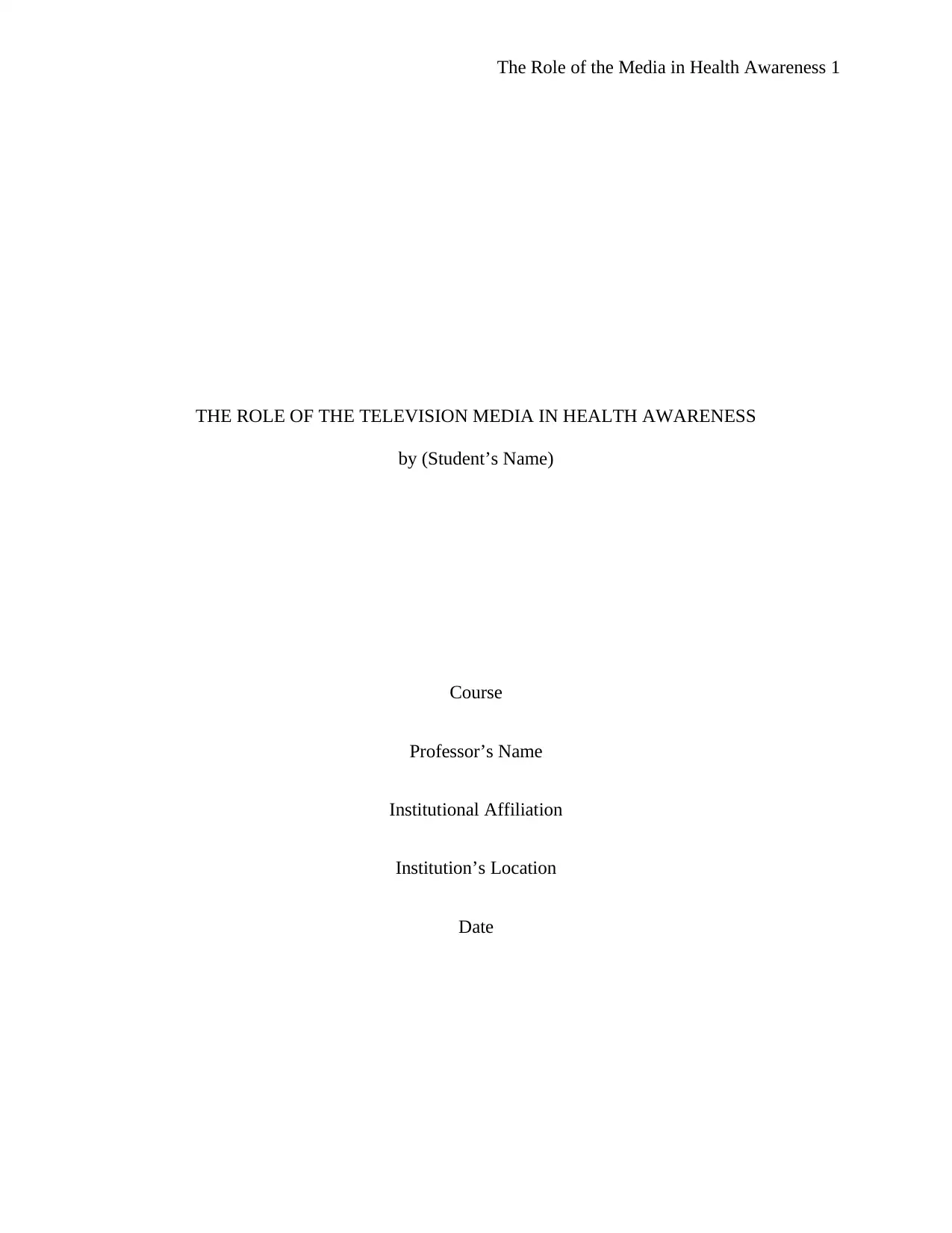
The Role of the Media in Health Awareness 1
THE ROLE OF THE TELEVISION MEDIA IN HEALTH AWARENESS
by (Student’s Name)
Course
Professor’s Name
Institutional Affiliation
Institution’s Location
Date
THE ROLE OF THE TELEVISION MEDIA IN HEALTH AWARENESS
by (Student’s Name)
Course
Professor’s Name
Institutional Affiliation
Institution’s Location
Date
Paraphrase This Document
Need a fresh take? Get an instant paraphrase of this document with our AI Paraphraser
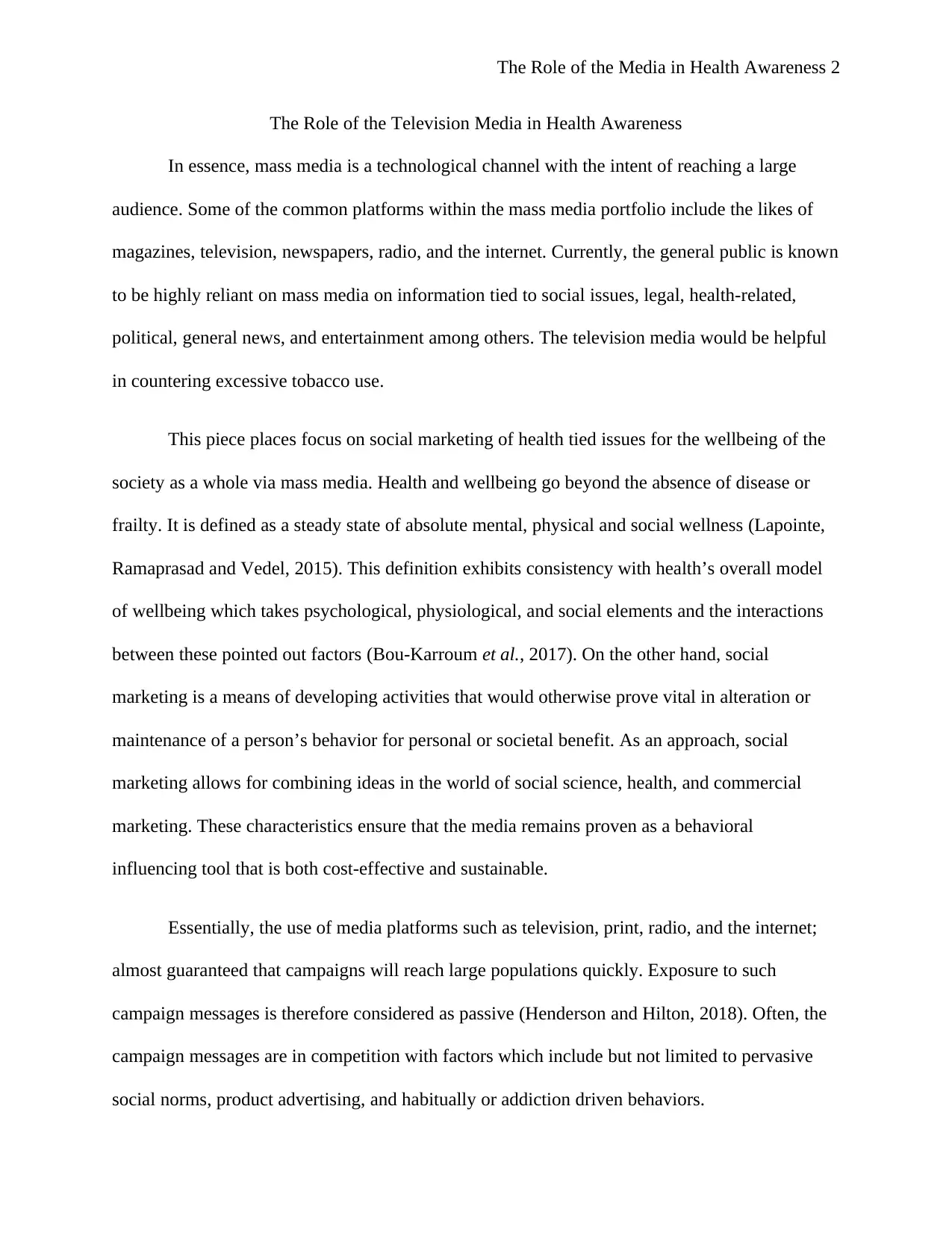
The Role of the Media in Health Awareness 2
The Role of the Television Media in Health Awareness
In essence, mass media is a technological channel with the intent of reaching a large
audience. Some of the common platforms within the mass media portfolio include the likes of
magazines, television, newspapers, radio, and the internet. Currently, the general public is known
to be highly reliant on mass media on information tied to social issues, legal, health-related,
political, general news, and entertainment among others. The television media would be helpful
in countering excessive tobacco use.
This piece places focus on social marketing of health tied issues for the wellbeing of the
society as a whole via mass media. Health and wellbeing go beyond the absence of disease or
frailty. It is defined as a steady state of absolute mental, physical and social wellness (Lapointe,
Ramaprasad and Vedel, 2015). This definition exhibits consistency with health’s overall model
of wellbeing which takes psychological, physiological, and social elements and the interactions
between these pointed out factors (Bou-Karroum et al., 2017). On the other hand, social
marketing is a means of developing activities that would otherwise prove vital in alteration or
maintenance of a person’s behavior for personal or societal benefit. As an approach, social
marketing allows for combining ideas in the world of social science, health, and commercial
marketing. These characteristics ensure that the media remains proven as a behavioral
influencing tool that is both cost-effective and sustainable.
Essentially, the use of media platforms such as television, print, radio, and the internet;
almost guaranteed that campaigns will reach large populations quickly. Exposure to such
campaign messages is therefore considered as passive (Henderson and Hilton, 2018). Often, the
campaign messages are in competition with factors which include but not limited to pervasive
social norms, product advertising, and habitually or addiction driven behaviors.
The Role of the Television Media in Health Awareness
In essence, mass media is a technological channel with the intent of reaching a large
audience. Some of the common platforms within the mass media portfolio include the likes of
magazines, television, newspapers, radio, and the internet. Currently, the general public is known
to be highly reliant on mass media on information tied to social issues, legal, health-related,
political, general news, and entertainment among others. The television media would be helpful
in countering excessive tobacco use.
This piece places focus on social marketing of health tied issues for the wellbeing of the
society as a whole via mass media. Health and wellbeing go beyond the absence of disease or
frailty. It is defined as a steady state of absolute mental, physical and social wellness (Lapointe,
Ramaprasad and Vedel, 2015). This definition exhibits consistency with health’s overall model
of wellbeing which takes psychological, physiological, and social elements and the interactions
between these pointed out factors (Bou-Karroum et al., 2017). On the other hand, social
marketing is a means of developing activities that would otherwise prove vital in alteration or
maintenance of a person’s behavior for personal or societal benefit. As an approach, social
marketing allows for combining ideas in the world of social science, health, and commercial
marketing. These characteristics ensure that the media remains proven as a behavioral
influencing tool that is both cost-effective and sustainable.
Essentially, the use of media platforms such as television, print, radio, and the internet;
almost guaranteed that campaigns will reach large populations quickly. Exposure to such
campaign messages is therefore considered as passive (Henderson and Hilton, 2018). Often, the
campaign messages are in competition with factors which include but not limited to pervasive
social norms, product advertising, and habitually or addiction driven behaviors.
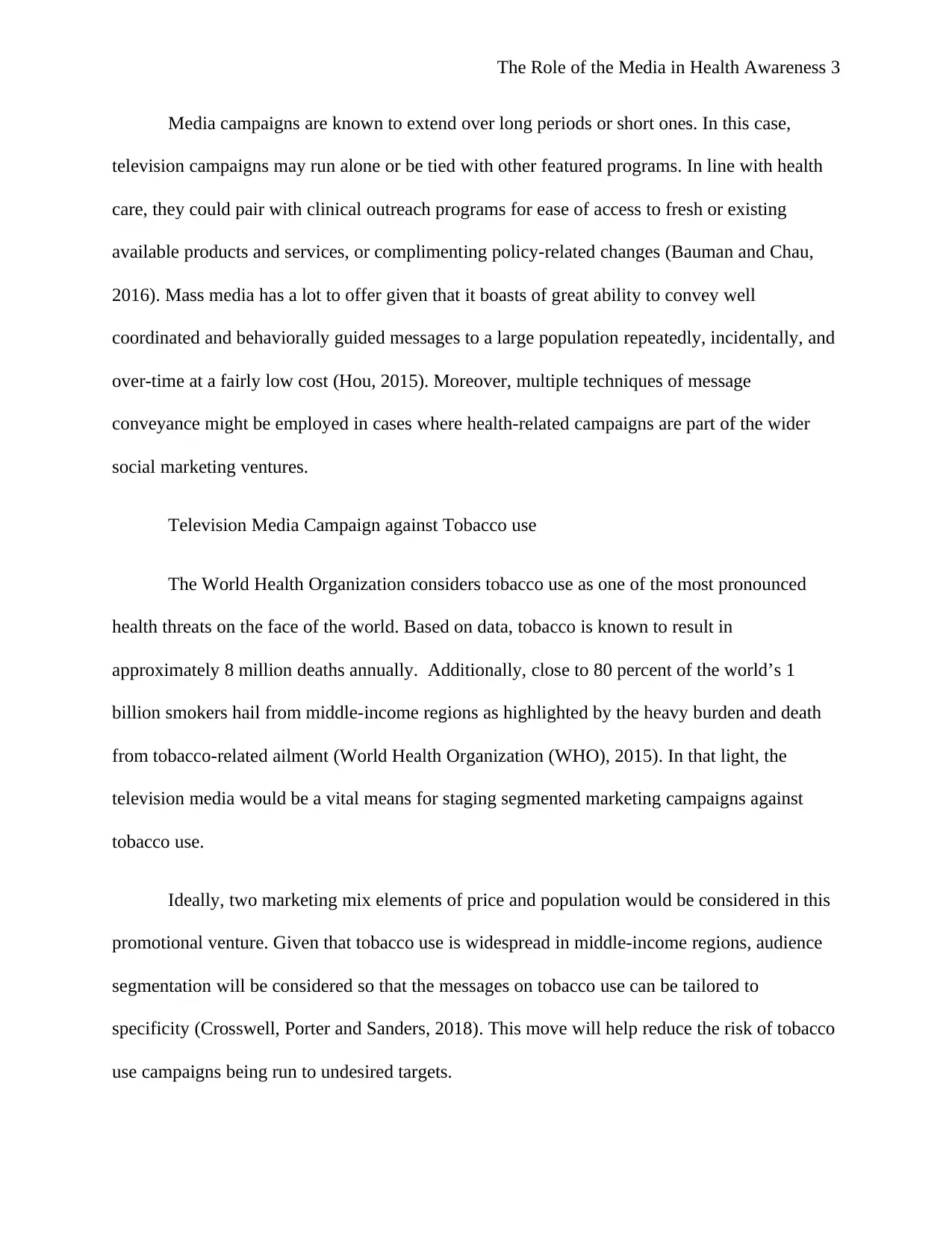
The Role of the Media in Health Awareness 3
Media campaigns are known to extend over long periods or short ones. In this case,
television campaigns may run alone or be tied with other featured programs. In line with health
care, they could pair with clinical outreach programs for ease of access to fresh or existing
available products and services, or complimenting policy-related changes (Bauman and Chau,
2016). Mass media has a lot to offer given that it boasts of great ability to convey well
coordinated and behaviorally guided messages to a large population repeatedly, incidentally, and
over-time at a fairly low cost (Hou, 2015). Moreover, multiple techniques of message
conveyance might be employed in cases where health-related campaigns are part of the wider
social marketing ventures.
Television Media Campaign against Tobacco use
The World Health Organization considers tobacco use as one of the most pronounced
health threats on the face of the world. Based on data, tobacco is known to result in
approximately 8 million deaths annually. Additionally, close to 80 percent of the world’s 1
billion smokers hail from middle-income regions as highlighted by the heavy burden and death
from tobacco-related ailment (World Health Organization (WHO), 2015). In that light, the
television media would be a vital means for staging segmented marketing campaigns against
tobacco use.
Ideally, two marketing mix elements of price and population would be considered in this
promotional venture. Given that tobacco use is widespread in middle-income regions, audience
segmentation will be considered so that the messages on tobacco use can be tailored to
specificity (Crosswell, Porter and Sanders, 2018). This move will help reduce the risk of tobacco
use campaigns being run to undesired targets.
Media campaigns are known to extend over long periods or short ones. In this case,
television campaigns may run alone or be tied with other featured programs. In line with health
care, they could pair with clinical outreach programs for ease of access to fresh or existing
available products and services, or complimenting policy-related changes (Bauman and Chau,
2016). Mass media has a lot to offer given that it boasts of great ability to convey well
coordinated and behaviorally guided messages to a large population repeatedly, incidentally, and
over-time at a fairly low cost (Hou, 2015). Moreover, multiple techniques of message
conveyance might be employed in cases where health-related campaigns are part of the wider
social marketing ventures.
Television Media Campaign against Tobacco use
The World Health Organization considers tobacco use as one of the most pronounced
health threats on the face of the world. Based on data, tobacco is known to result in
approximately 8 million deaths annually. Additionally, close to 80 percent of the world’s 1
billion smokers hail from middle-income regions as highlighted by the heavy burden and death
from tobacco-related ailment (World Health Organization (WHO), 2015). In that light, the
television media would be a vital means for staging segmented marketing campaigns against
tobacco use.
Ideally, two marketing mix elements of price and population would be considered in this
promotional venture. Given that tobacco use is widespread in middle-income regions, audience
segmentation will be considered so that the messages on tobacco use can be tailored to
specificity (Crosswell, Porter and Sanders, 2018). This move will help reduce the risk of tobacco
use campaigns being run to undesired targets.
⊘ This is a preview!⊘
Do you want full access?
Subscribe today to unlock all pages.

Trusted by 1+ million students worldwide
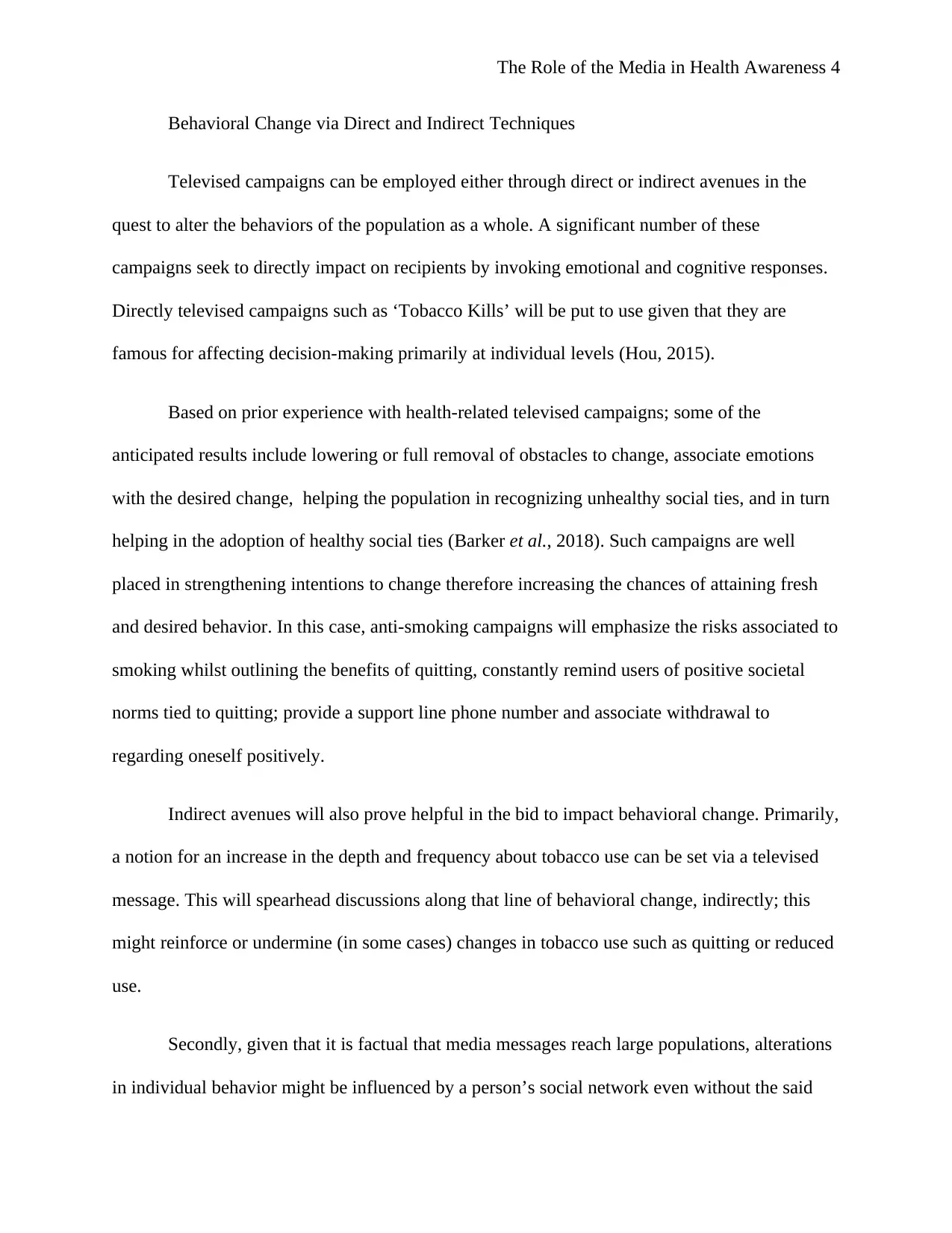
The Role of the Media in Health Awareness 4
Behavioral Change via Direct and Indirect Techniques
Televised campaigns can be employed either through direct or indirect avenues in the
quest to alter the behaviors of the population as a whole. A significant number of these
campaigns seek to directly impact on recipients by invoking emotional and cognitive responses.
Directly televised campaigns such as ‘Tobacco Kills’ will be put to use given that they are
famous for affecting decision-making primarily at individual levels (Hou, 2015).
Based on prior experience with health-related televised campaigns; some of the
anticipated results include lowering or full removal of obstacles to change, associate emotions
with the desired change, helping the population in recognizing unhealthy social ties, and in turn
helping in the adoption of healthy social ties (Barker et al., 2018). Such campaigns are well
placed in strengthening intentions to change therefore increasing the chances of attaining fresh
and desired behavior. In this case, anti-smoking campaigns will emphasize the risks associated to
smoking whilst outlining the benefits of quitting, constantly remind users of positive societal
norms tied to quitting; provide a support line phone number and associate withdrawal to
regarding oneself positively.
Indirect avenues will also prove helpful in the bid to impact behavioral change. Primarily,
a notion for an increase in the depth and frequency about tobacco use can be set via a televised
message. This will spearhead discussions along that line of behavioral change, indirectly; this
might reinforce or undermine (in some cases) changes in tobacco use such as quitting or reduced
use.
Secondly, given that it is factual that media messages reach large populations, alterations
in individual behavior might be influenced by a person’s social network even without the said
Behavioral Change via Direct and Indirect Techniques
Televised campaigns can be employed either through direct or indirect avenues in the
quest to alter the behaviors of the population as a whole. A significant number of these
campaigns seek to directly impact on recipients by invoking emotional and cognitive responses.
Directly televised campaigns such as ‘Tobacco Kills’ will be put to use given that they are
famous for affecting decision-making primarily at individual levels (Hou, 2015).
Based on prior experience with health-related televised campaigns; some of the
anticipated results include lowering or full removal of obstacles to change, associate emotions
with the desired change, helping the population in recognizing unhealthy social ties, and in turn
helping in the adoption of healthy social ties (Barker et al., 2018). Such campaigns are well
placed in strengthening intentions to change therefore increasing the chances of attaining fresh
and desired behavior. In this case, anti-smoking campaigns will emphasize the risks associated to
smoking whilst outlining the benefits of quitting, constantly remind users of positive societal
norms tied to quitting; provide a support line phone number and associate withdrawal to
regarding oneself positively.
Indirect avenues will also prove helpful in the bid to impact behavioral change. Primarily,
a notion for an increase in the depth and frequency about tobacco use can be set via a televised
message. This will spearhead discussions along that line of behavioral change, indirectly; this
might reinforce or undermine (in some cases) changes in tobacco use such as quitting or reduced
use.
Secondly, given that it is factual that media messages reach large populations, alterations
in individual behavior might be influenced by a person’s social network even without the said
Paraphrase This Document
Need a fresh take? Get an instant paraphrase of this document with our AI Paraphraser
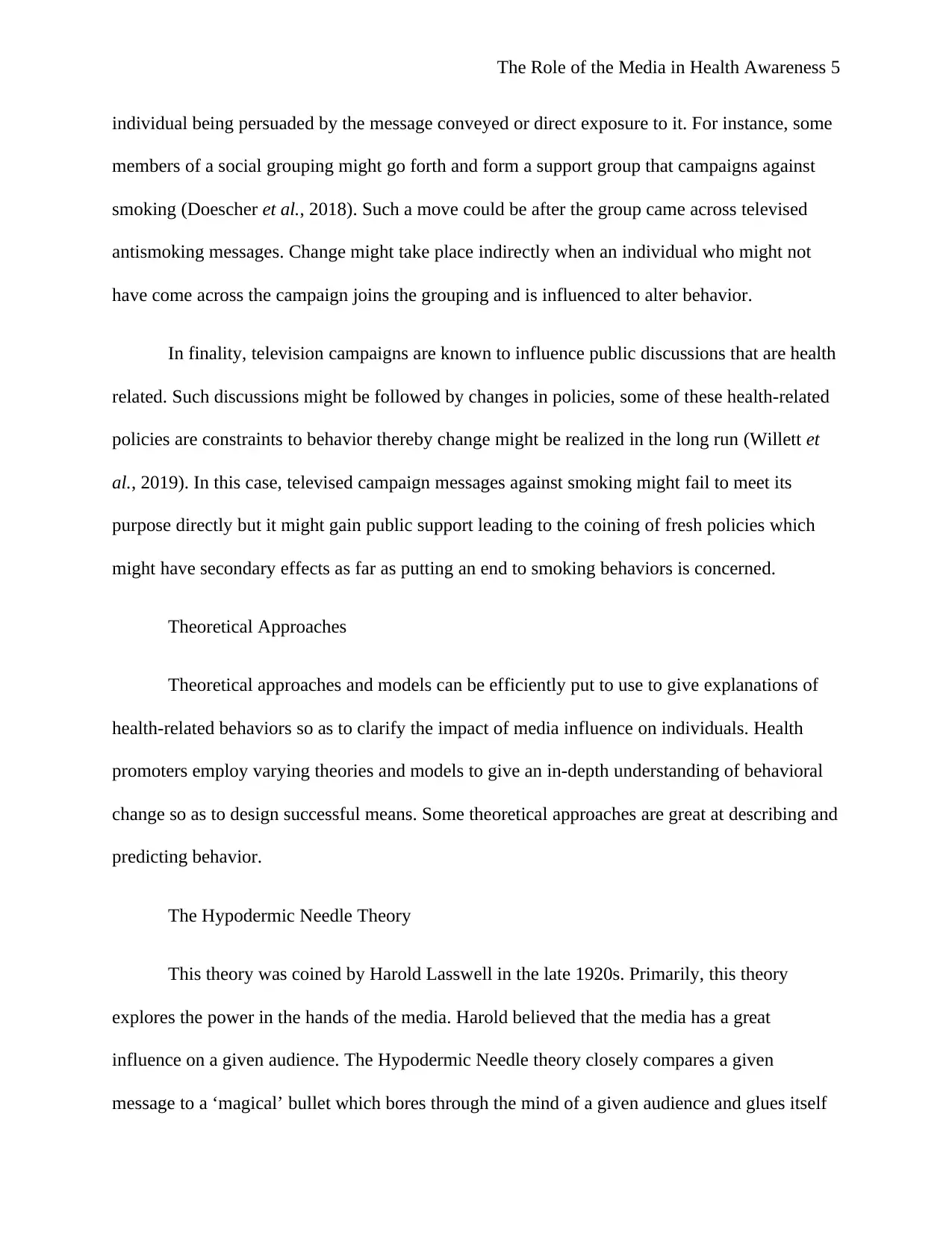
The Role of the Media in Health Awareness 5
individual being persuaded by the message conveyed or direct exposure to it. For instance, some
members of a social grouping might go forth and form a support group that campaigns against
smoking (Doescher et al., 2018). Such a move could be after the group came across televised
antismoking messages. Change might take place indirectly when an individual who might not
have come across the campaign joins the grouping and is influenced to alter behavior.
In finality, television campaigns are known to influence public discussions that are health
related. Such discussions might be followed by changes in policies, some of these health-related
policies are constraints to behavior thereby change might be realized in the long run (Willett et
al., 2019). In this case, televised campaign messages against smoking might fail to meet its
purpose directly but it might gain public support leading to the coining of fresh policies which
might have secondary effects as far as putting an end to smoking behaviors is concerned.
Theoretical Approaches
Theoretical approaches and models can be efficiently put to use to give explanations of
health-related behaviors so as to clarify the impact of media influence on individuals. Health
promoters employ varying theories and models to give an in-depth understanding of behavioral
change so as to design successful means. Some theoretical approaches are great at describing and
predicting behavior.
The Hypodermic Needle Theory
This theory was coined by Harold Lasswell in the late 1920s. Primarily, this theory
explores the power in the hands of the media. Harold believed that the media has a great
influence on a given audience. The Hypodermic Needle theory closely compares a given
message to a ‘magical’ bullet which bores through the mind of a given audience and glues itself
individual being persuaded by the message conveyed or direct exposure to it. For instance, some
members of a social grouping might go forth and form a support group that campaigns against
smoking (Doescher et al., 2018). Such a move could be after the group came across televised
antismoking messages. Change might take place indirectly when an individual who might not
have come across the campaign joins the grouping and is influenced to alter behavior.
In finality, television campaigns are known to influence public discussions that are health
related. Such discussions might be followed by changes in policies, some of these health-related
policies are constraints to behavior thereby change might be realized in the long run (Willett et
al., 2019). In this case, televised campaign messages against smoking might fail to meet its
purpose directly but it might gain public support leading to the coining of fresh policies which
might have secondary effects as far as putting an end to smoking behaviors is concerned.
Theoretical Approaches
Theoretical approaches and models can be efficiently put to use to give explanations of
health-related behaviors so as to clarify the impact of media influence on individuals. Health
promoters employ varying theories and models to give an in-depth understanding of behavioral
change so as to design successful means. Some theoretical approaches are great at describing and
predicting behavior.
The Hypodermic Needle Theory
This theory was coined by Harold Lasswell in the late 1920s. Primarily, this theory
explores the power in the hands of the media. Harold believed that the media has a great
influence on a given audience. The Hypodermic Needle theory closely compares a given
message to a ‘magical’ bullet which bores through the mind of a given audience and glues itself
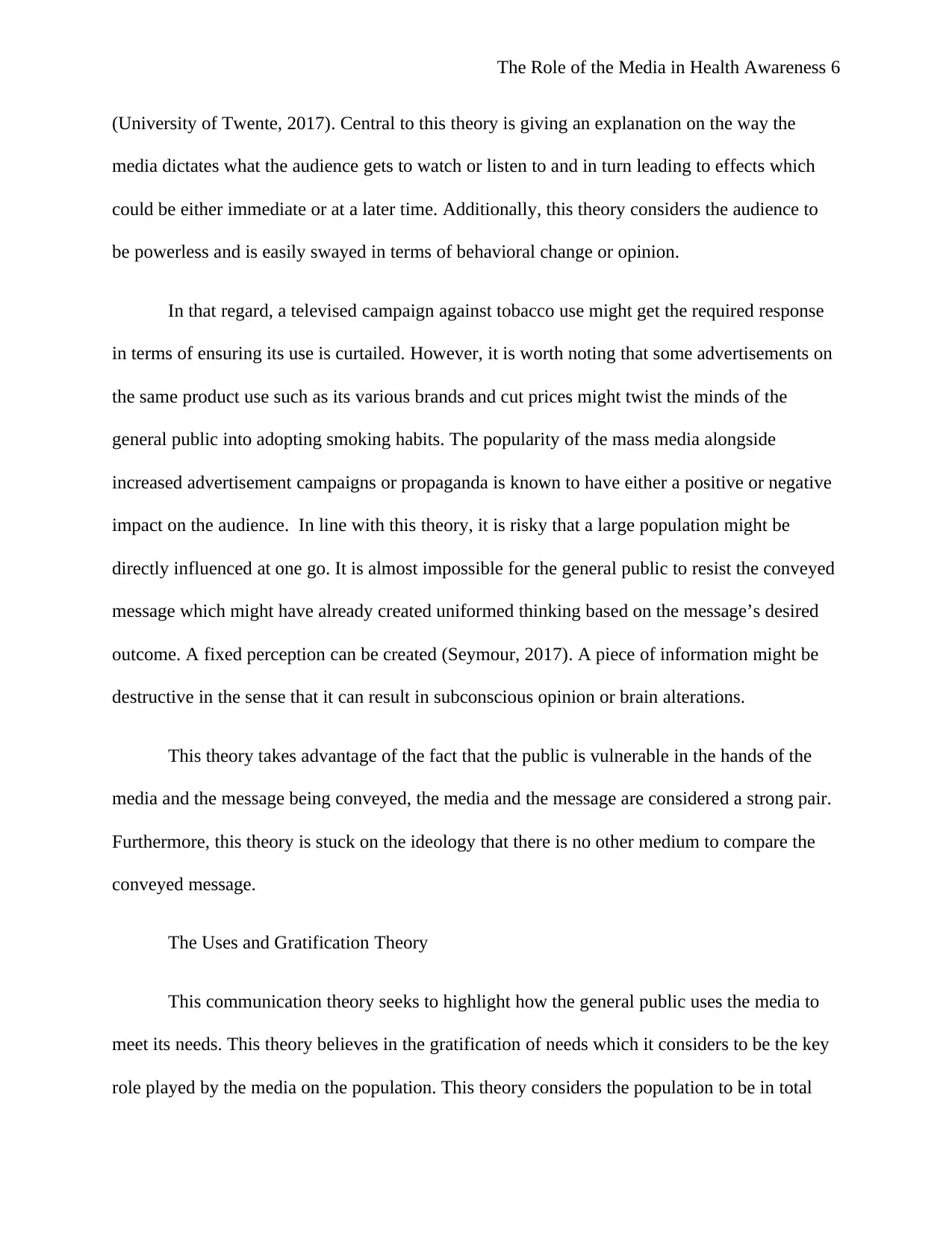
The Role of the Media in Health Awareness 6
(University of Twente, 2017). Central to this theory is giving an explanation on the way the
media dictates what the audience gets to watch or listen to and in turn leading to effects which
could be either immediate or at a later time. Additionally, this theory considers the audience to
be powerless and is easily swayed in terms of behavioral change or opinion.
In that regard, a televised campaign against tobacco use might get the required response
in terms of ensuring its use is curtailed. However, it is worth noting that some advertisements on
the same product use such as its various brands and cut prices might twist the minds of the
general public into adopting smoking habits. The popularity of the mass media alongside
increased advertisement campaigns or propaganda is known to have either a positive or negative
impact on the audience. In line with this theory, it is risky that a large population might be
directly influenced at one go. It is almost impossible for the general public to resist the conveyed
message which might have already created uniformed thinking based on the message’s desired
outcome. A fixed perception can be created (Seymour, 2017). A piece of information might be
destructive in the sense that it can result in subconscious opinion or brain alterations.
This theory takes advantage of the fact that the public is vulnerable in the hands of the
media and the message being conveyed, the media and the message are considered a strong pair.
Furthermore, this theory is stuck on the ideology that there is no other medium to compare the
conveyed message.
The Uses and Gratification Theory
This communication theory seeks to highlight how the general public uses the media to
meet its needs. This theory believes in the gratification of needs which it considers to be the key
role played by the media on the population. This theory considers the population to be in total
(University of Twente, 2017). Central to this theory is giving an explanation on the way the
media dictates what the audience gets to watch or listen to and in turn leading to effects which
could be either immediate or at a later time. Additionally, this theory considers the audience to
be powerless and is easily swayed in terms of behavioral change or opinion.
In that regard, a televised campaign against tobacco use might get the required response
in terms of ensuring its use is curtailed. However, it is worth noting that some advertisements on
the same product use such as its various brands and cut prices might twist the minds of the
general public into adopting smoking habits. The popularity of the mass media alongside
increased advertisement campaigns or propaganda is known to have either a positive or negative
impact on the audience. In line with this theory, it is risky that a large population might be
directly influenced at one go. It is almost impossible for the general public to resist the conveyed
message which might have already created uniformed thinking based on the message’s desired
outcome. A fixed perception can be created (Seymour, 2017). A piece of information might be
destructive in the sense that it can result in subconscious opinion or brain alterations.
This theory takes advantage of the fact that the public is vulnerable in the hands of the
media and the message being conveyed, the media and the message are considered a strong pair.
Furthermore, this theory is stuck on the ideology that there is no other medium to compare the
conveyed message.
The Uses and Gratification Theory
This communication theory seeks to highlight how the general public uses the media to
meet its needs. This theory believes in the gratification of needs which it considers to be the key
role played by the media on the population. This theory considers the population to be in total
⊘ This is a preview!⊘
Do you want full access?
Subscribe today to unlock all pages.

Trusted by 1+ million students worldwide
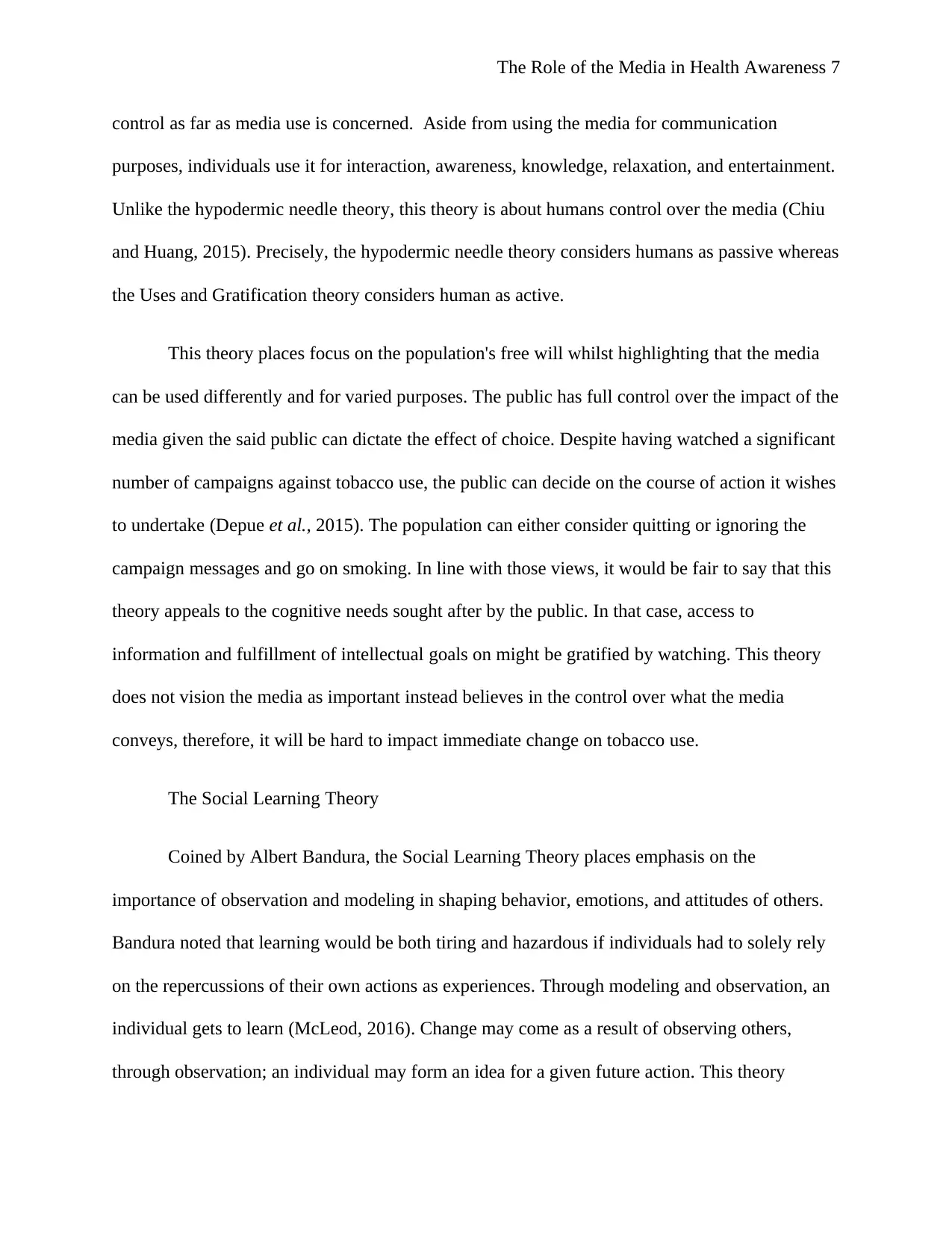
The Role of the Media in Health Awareness 7
control as far as media use is concerned. Aside from using the media for communication
purposes, individuals use it for interaction, awareness, knowledge, relaxation, and entertainment.
Unlike the hypodermic needle theory, this theory is about humans control over the media (Chiu
and Huang, 2015). Precisely, the hypodermic needle theory considers humans as passive whereas
the Uses and Gratification theory considers human as active.
This theory places focus on the population's free will whilst highlighting that the media
can be used differently and for varied purposes. The public has full control over the impact of the
media given the said public can dictate the effect of choice. Despite having watched a significant
number of campaigns against tobacco use, the public can decide on the course of action it wishes
to undertake (Depue et al., 2015). The population can either consider quitting or ignoring the
campaign messages and go on smoking. In line with those views, it would be fair to say that this
theory appeals to the cognitive needs sought after by the public. In that case, access to
information and fulfillment of intellectual goals on might be gratified by watching. This theory
does not vision the media as important instead believes in the control over what the media
conveys, therefore, it will be hard to impact immediate change on tobacco use.
The Social Learning Theory
Coined by Albert Bandura, the Social Learning Theory places emphasis on the
importance of observation and modeling in shaping behavior, emotions, and attitudes of others.
Bandura noted that learning would be both tiring and hazardous if individuals had to solely rely
on the repercussions of their own actions as experiences. Through modeling and observation, an
individual gets to learn (McLeod, 2016). Change may come as a result of observing others,
through observation; an individual may form an idea for a given future action. This theory
control as far as media use is concerned. Aside from using the media for communication
purposes, individuals use it for interaction, awareness, knowledge, relaxation, and entertainment.
Unlike the hypodermic needle theory, this theory is about humans control over the media (Chiu
and Huang, 2015). Precisely, the hypodermic needle theory considers humans as passive whereas
the Uses and Gratification theory considers human as active.
This theory places focus on the population's free will whilst highlighting that the media
can be used differently and for varied purposes. The public has full control over the impact of the
media given the said public can dictate the effect of choice. Despite having watched a significant
number of campaigns against tobacco use, the public can decide on the course of action it wishes
to undertake (Depue et al., 2015). The population can either consider quitting or ignoring the
campaign messages and go on smoking. In line with those views, it would be fair to say that this
theory appeals to the cognitive needs sought after by the public. In that case, access to
information and fulfillment of intellectual goals on might be gratified by watching. This theory
does not vision the media as important instead believes in the control over what the media
conveys, therefore, it will be hard to impact immediate change on tobacco use.
The Social Learning Theory
Coined by Albert Bandura, the Social Learning Theory places emphasis on the
importance of observation and modeling in shaping behavior, emotions, and attitudes of others.
Bandura noted that learning would be both tiring and hazardous if individuals had to solely rely
on the repercussions of their own actions as experiences. Through modeling and observation, an
individual gets to learn (McLeod, 2016). Change may come as a result of observing others,
through observation; an individual may form an idea for a given future action. This theory
Paraphrase This Document
Need a fresh take? Get an instant paraphrase of this document with our AI Paraphraser
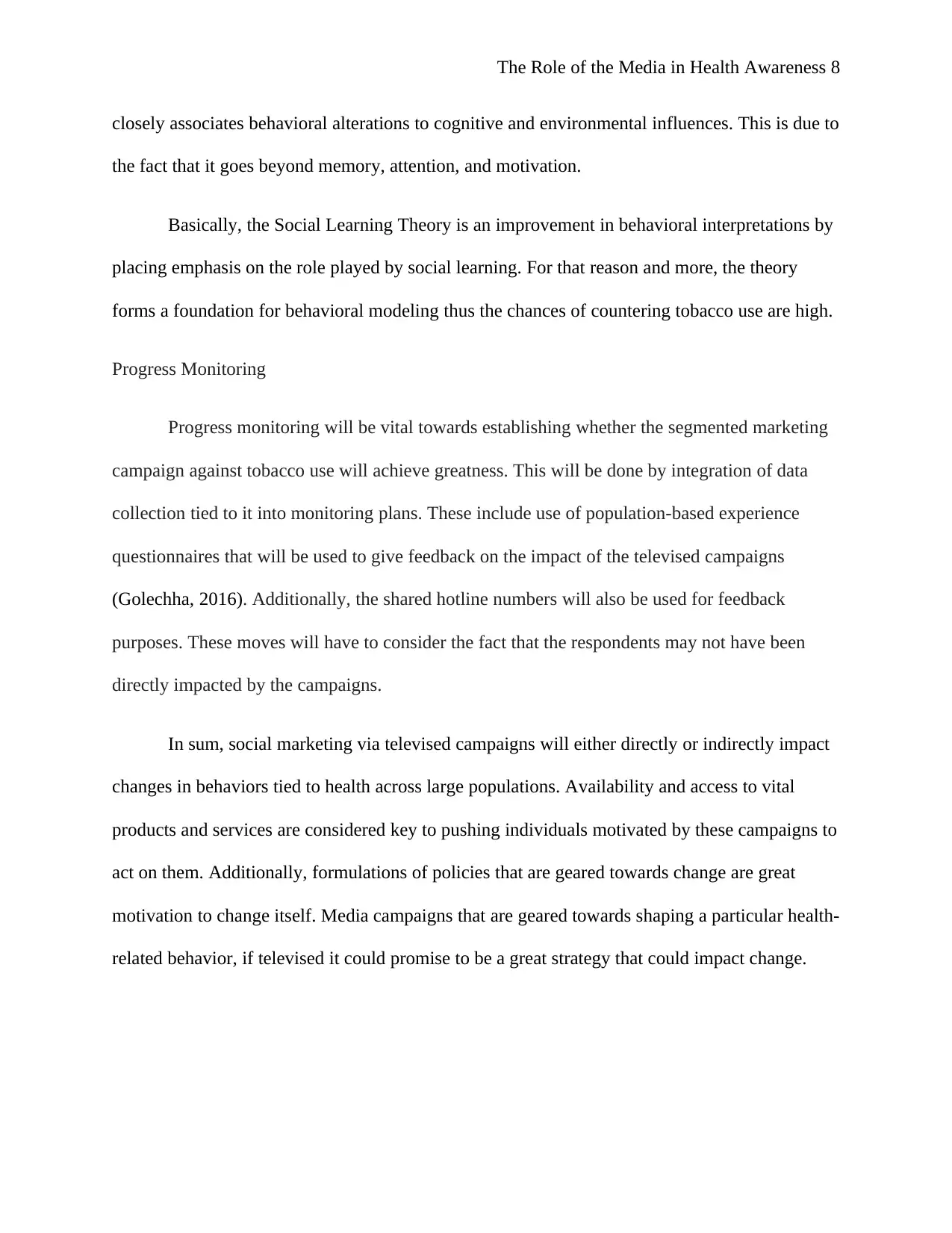
The Role of the Media in Health Awareness 8
closely associates behavioral alterations to cognitive and environmental influences. This is due to
the fact that it goes beyond memory, attention, and motivation.
Basically, the Social Learning Theory is an improvement in behavioral interpretations by
placing emphasis on the role played by social learning. For that reason and more, the theory
forms a foundation for behavioral modeling thus the chances of countering tobacco use are high.
Progress Monitoring
Progress monitoring will be vital towards establishing whether the segmented marketing
campaign against tobacco use will achieve greatness. This will be done by integration of data
collection tied to it into monitoring plans. These include use of population-based experience
questionnaires that will be used to give feedback on the impact of the televised campaigns
(Golechha, 2016). Additionally, the shared hotline numbers will also be used for feedback
purposes. These moves will have to consider the fact that the respondents may not have been
directly impacted by the campaigns.
In sum, social marketing via televised campaigns will either directly or indirectly impact
changes in behaviors tied to health across large populations. Availability and access to vital
products and services are considered key to pushing individuals motivated by these campaigns to
act on them. Additionally, formulations of policies that are geared towards change are great
motivation to change itself. Media campaigns that are geared towards shaping a particular health-
related behavior, if televised it could promise to be a great strategy that could impact change.
closely associates behavioral alterations to cognitive and environmental influences. This is due to
the fact that it goes beyond memory, attention, and motivation.
Basically, the Social Learning Theory is an improvement in behavioral interpretations by
placing emphasis on the role played by social learning. For that reason and more, the theory
forms a foundation for behavioral modeling thus the chances of countering tobacco use are high.
Progress Monitoring
Progress monitoring will be vital towards establishing whether the segmented marketing
campaign against tobacco use will achieve greatness. This will be done by integration of data
collection tied to it into monitoring plans. These include use of population-based experience
questionnaires that will be used to give feedback on the impact of the televised campaigns
(Golechha, 2016). Additionally, the shared hotline numbers will also be used for feedback
purposes. These moves will have to consider the fact that the respondents may not have been
directly impacted by the campaigns.
In sum, social marketing via televised campaigns will either directly or indirectly impact
changes in behaviors tied to health across large populations. Availability and access to vital
products and services are considered key to pushing individuals motivated by these campaigns to
act on them. Additionally, formulations of policies that are geared towards change are great
motivation to change itself. Media campaigns that are geared towards shaping a particular health-
related behavior, if televised it could promise to be a great strategy that could impact change.
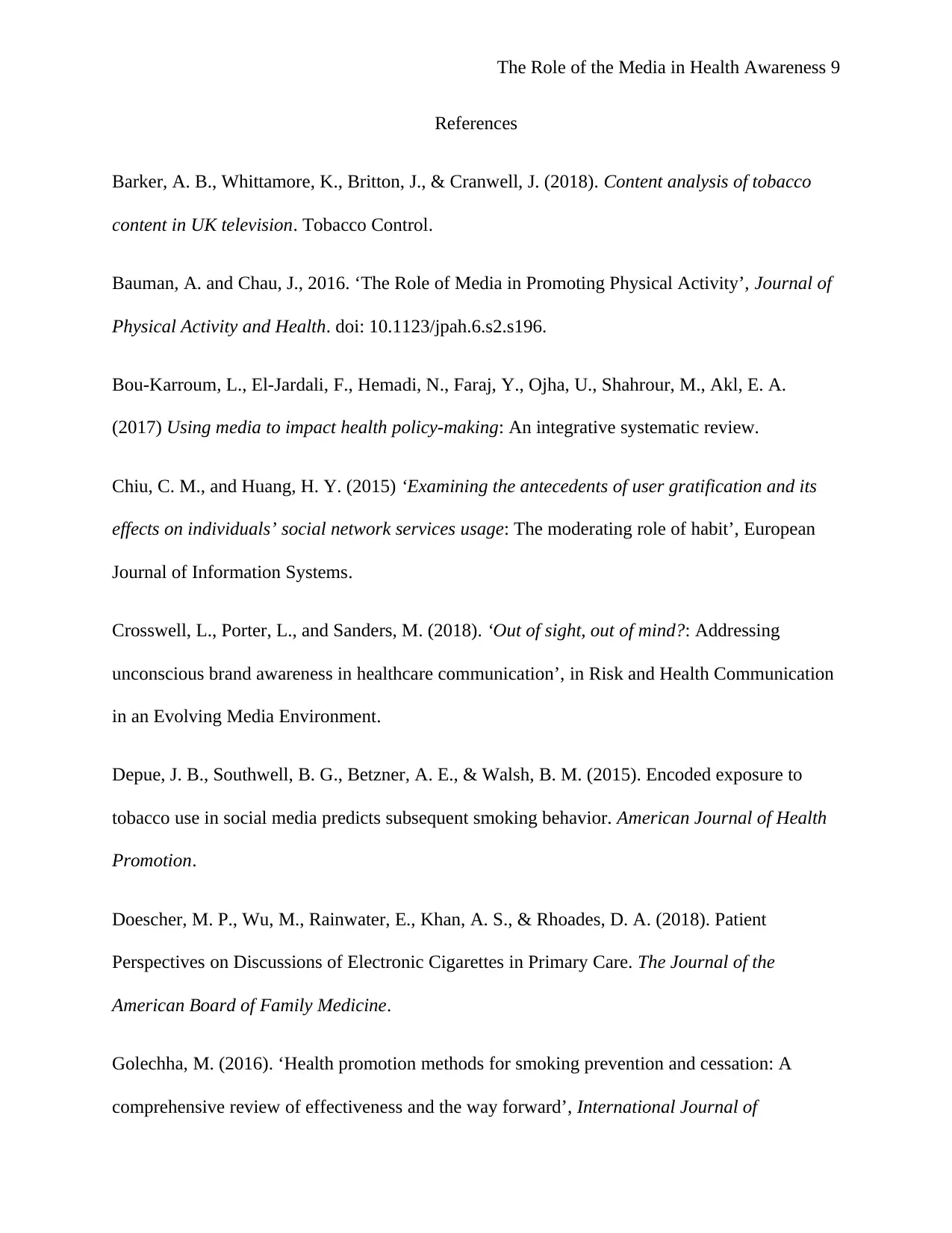
The Role of the Media in Health Awareness 9
References
Barker, A. B., Whittamore, K., Britton, J., & Cranwell, J. (2018). Content analysis of tobacco
content in UK television. Tobacco Control.
Bauman, A. and Chau, J., 2016. ‘The Role of Media in Promoting Physical Activity’, Journal of
Physical Activity and Health. doi: 10.1123/jpah.6.s2.s196.
Bou-Karroum, L., El-Jardali, F., Hemadi, N., Faraj, Y., Ojha, U., Shahrour, M., Akl, E. A.
(2017) Using media to impact health policy-making: An integrative systematic review.
Chiu, C. M., and Huang, H. Y. (2015) ‘Examining the antecedents of user gratification and its
effects on individuals’ social network services usage: The moderating role of habit’, European
Journal of Information Systems.
Crosswell, L., Porter, L., and Sanders, M. (2018). ‘Out of sight, out of mind?: Addressing
unconscious brand awareness in healthcare communication’, in Risk and Health Communication
in an Evolving Media Environment.
Depue, J. B., Southwell, B. G., Betzner, A. E., & Walsh, B. M. (2015). Encoded exposure to
tobacco use in social media predicts subsequent smoking behavior. American Journal of Health
Promotion.
Doescher, M. P., Wu, M., Rainwater, E., Khan, A. S., & Rhoades, D. A. (2018). Patient
Perspectives on Discussions of Electronic Cigarettes in Primary Care. The Journal of the
American Board of Family Medicine.
Golechha, M. (2016). ‘Health promotion methods for smoking prevention and cessation: A
comprehensive review of effectiveness and the way forward’, International Journal of
References
Barker, A. B., Whittamore, K., Britton, J., & Cranwell, J. (2018). Content analysis of tobacco
content in UK television. Tobacco Control.
Bauman, A. and Chau, J., 2016. ‘The Role of Media in Promoting Physical Activity’, Journal of
Physical Activity and Health. doi: 10.1123/jpah.6.s2.s196.
Bou-Karroum, L., El-Jardali, F., Hemadi, N., Faraj, Y., Ojha, U., Shahrour, M., Akl, E. A.
(2017) Using media to impact health policy-making: An integrative systematic review.
Chiu, C. M., and Huang, H. Y. (2015) ‘Examining the antecedents of user gratification and its
effects on individuals’ social network services usage: The moderating role of habit’, European
Journal of Information Systems.
Crosswell, L., Porter, L., and Sanders, M. (2018). ‘Out of sight, out of mind?: Addressing
unconscious brand awareness in healthcare communication’, in Risk and Health Communication
in an Evolving Media Environment.
Depue, J. B., Southwell, B. G., Betzner, A. E., & Walsh, B. M. (2015). Encoded exposure to
tobacco use in social media predicts subsequent smoking behavior. American Journal of Health
Promotion.
Doescher, M. P., Wu, M., Rainwater, E., Khan, A. S., & Rhoades, D. A. (2018). Patient
Perspectives on Discussions of Electronic Cigarettes in Primary Care. The Journal of the
American Board of Family Medicine.
Golechha, M. (2016). ‘Health promotion methods for smoking prevention and cessation: A
comprehensive review of effectiveness and the way forward’, International Journal of
⊘ This is a preview!⊘
Do you want full access?
Subscribe today to unlock all pages.

Trusted by 1+ million students worldwide
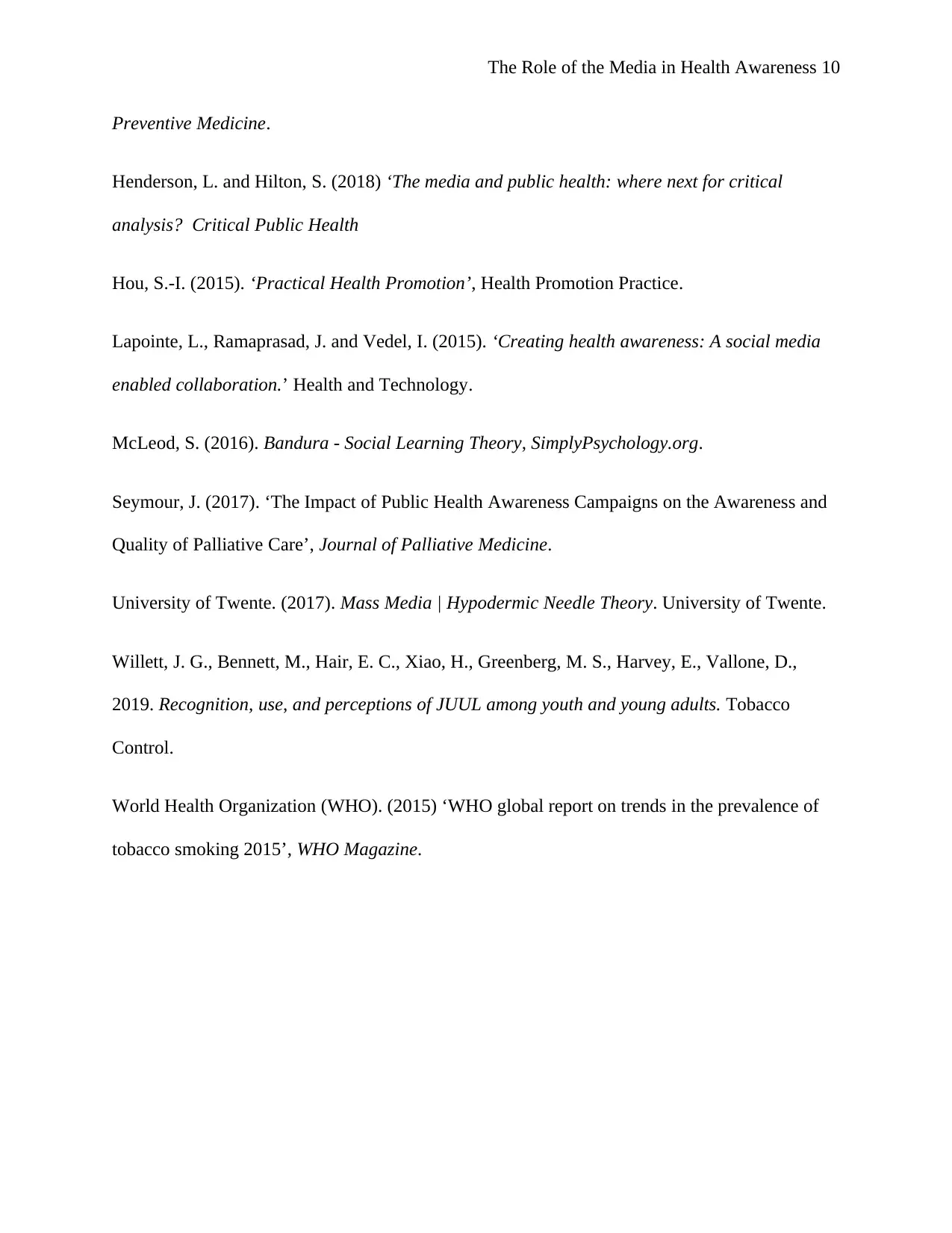
The Role of the Media in Health Awareness 10
Preventive Medicine.
Henderson, L. and Hilton, S. (2018) ‘The media and public health: where next for critical
analysis? Critical Public Health
Hou, S.-I. (2015). ‘Practical Health Promotion’, Health Promotion Practice.
Lapointe, L., Ramaprasad, J. and Vedel, I. (2015). ‘Creating health awareness: A social media
enabled collaboration.’ Health and Technology.
McLeod, S. (2016). Bandura - Social Learning Theory, SimplyPsychology.org.
Seymour, J. (2017). ‘The Impact of Public Health Awareness Campaigns on the Awareness and
Quality of Palliative Care’, Journal of Palliative Medicine.
University of Twente. (2017). Mass Media | Hypodermic Needle Theory. University of Twente.
Willett, J. G., Bennett, M., Hair, E. C., Xiao, H., Greenberg, M. S., Harvey, E., Vallone, D.,
2019. Recognition, use, and perceptions of JUUL among youth and young adults. Tobacco
Control.
World Health Organization (WHO). (2015) ‘WHO global report on trends in the prevalence of
tobacco smoking 2015’, WHO Magazine.
Preventive Medicine.
Henderson, L. and Hilton, S. (2018) ‘The media and public health: where next for critical
analysis? Critical Public Health
Hou, S.-I. (2015). ‘Practical Health Promotion’, Health Promotion Practice.
Lapointe, L., Ramaprasad, J. and Vedel, I. (2015). ‘Creating health awareness: A social media
enabled collaboration.’ Health and Technology.
McLeod, S. (2016). Bandura - Social Learning Theory, SimplyPsychology.org.
Seymour, J. (2017). ‘The Impact of Public Health Awareness Campaigns on the Awareness and
Quality of Palliative Care’, Journal of Palliative Medicine.
University of Twente. (2017). Mass Media | Hypodermic Needle Theory. University of Twente.
Willett, J. G., Bennett, M., Hair, E. C., Xiao, H., Greenberg, M. S., Harvey, E., Vallone, D.,
2019. Recognition, use, and perceptions of JUUL among youth and young adults. Tobacco
Control.
World Health Organization (WHO). (2015) ‘WHO global report on trends in the prevalence of
tobacco smoking 2015’, WHO Magazine.
1 out of 10
Related Documents
Your All-in-One AI-Powered Toolkit for Academic Success.
+13062052269
info@desklib.com
Available 24*7 on WhatsApp / Email
![[object Object]](/_next/static/media/star-bottom.7253800d.svg)
Unlock your academic potential
Copyright © 2020–2025 A2Z Services. All Rights Reserved. Developed and managed by ZUCOL.





